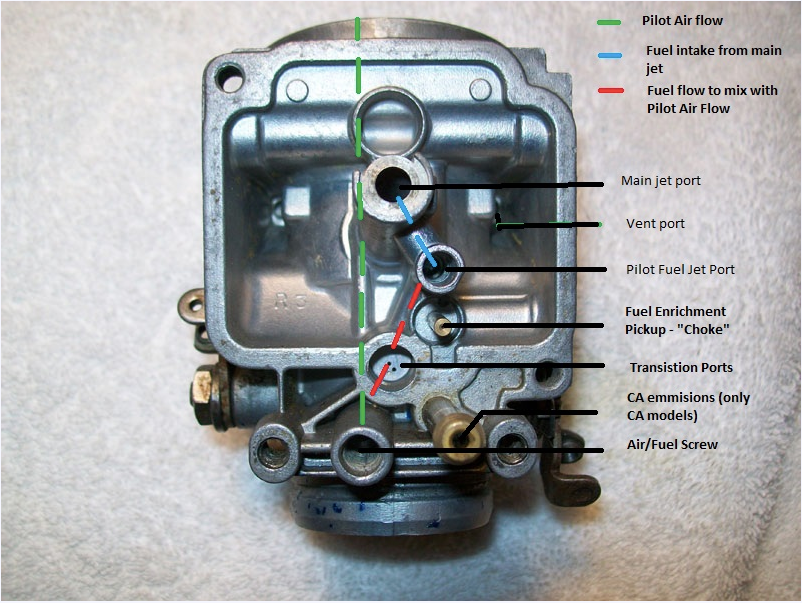Now I was thinking about this and did some googling but many people disagree with eachother.
Does the plug actually affect the mixture (when it's leaking or removed) or will the pilot jet always be the limiting factor?
Or in other words: did they design the carbs in such a way that the mixture is different when it goes via the main jet, or could you even run without the plugs as the pilot jet will always be what limits the fuel flow.
Interesting question...
I can't see what the purpose of the Rubber Plugs is.
But I can talk through the Pilot Jet a bit. Maybe that will help.
The Pilot Jet is shaped like a tiny combined version of the Main Jet + Emulsion Tube combination, so it's logical to assume it functions in a very similar fashion.
So the Pilot Jet has a small orifice at its bottom just like the Main Jet does. This means that just as with the Main Jet there has to be fuel sitting in the tube that the Pilot Jet is mounted in and that tube has to be full of fuel right up to the bottom of the Pilot Jet all the time, waiting to be sucked up and used.
But the design of the carb has the Pilot Jet screwed into the carb in a position just below the main intake bore, which puts its base (where its little fuel intake port is located) above the fuel level in the float bowls. This can only mean that when the bike isn't running the fuel level will sit below the bottom of the Pilot Jet.
I guess that means that when you start cranking the bike there might be a moment or two when the Pilot Jet doesn't actually work because it hasn't managed to suck the fuel upward to its little intake port.
Then there's the other half of the Pilot Jet that looks like a little miniature emulsion tube. The Suzuki Service Manual drawings don't show it but I understand that the Pilot Jet's mini-emulsion tube is actually connected to the Main Air Jet by a little tube (port, orifice, whatever you want to call it) that links it to the Main Air Jet by way of a connection to the area of the top of the Emulsion Tube, which means it is ultimately connected to the Main Air Jet.
Here's an illustration somebody did:

(it's a nice drawing even though it mis-identifies what is being supplied by the little connection port between the main Emulsion Tube and the Pilot Jet. The drawing labels the dashed blue line as being "intake fuel from main jet" which is wrong. It is obviously
air for the Pilot Jet's "miniature emulsion tube" not fuel, which obviously comes up through the "miniature main jet" orifice at the bottom of the Pilot Jet. If this wasn't the case then why would the Pilot Jet have an opening in its bottom?)
So, I still don't know what the Rubber Plugs are for...
But I've begun to wonder what would happen if that connector port between the Emulsion Tube and the Pilot Jet mini-emulsion tube got plugged up. If that connector couldn't feed air to the Pilot Jet's mini-emulsion tube then the engine vacuum would force the Pilot Jet to feed pure liquid fuel into the engine, making it run very rich.
Further, if that connector port air was even reduced at all by a partial blockage it would reduce the fuel emulsification in the Pilot Jet's mini-emulsion tube by some amount and have the effect of causing the engine to go toward a rich condition.